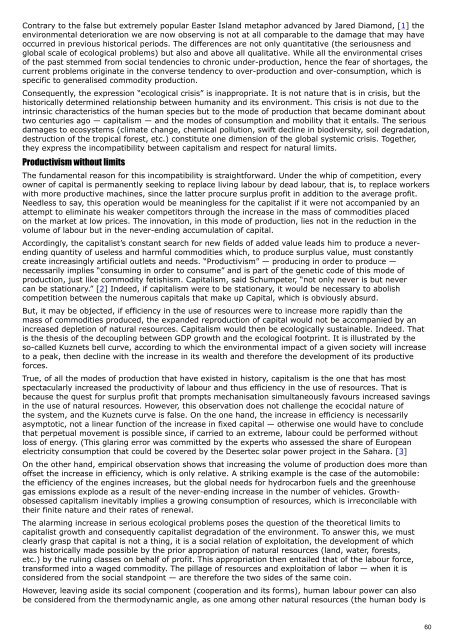here - International Viewpoint
here - International Viewpoint
here - International Viewpoint
You also want an ePaper? Increase the reach of your titles
YUMPU automatically turns print PDFs into web optimized ePapers that Google loves.
Contrary to the false but extremely popular Easter Island metaphor advanced by Jared Diamond, [1] the<br />
environmental deterioration we are now observing is not at all comparable to the damage that may have<br />
occurred in previous historical periods. The differences are not only quantitative (the seriousness and<br />
global scale of ecological problems) but also and above all qualitative. While all the environmental crises<br />
of the past stemmed from social tendencies to chronic under-production, hence the fear of shortages, the<br />
current problems originate in the converse tendency to over-production and over-consumption, which is<br />
specific to generalised commodity production.<br />
Consequently, the expression “ecological crisis” is inappropriate. It is not nature that is in crisis, but the<br />
historically determined relationship between humanity and its environment. This crisis is not due to the<br />
intrinsic characteristics of the human species but to the mode of production that became dominant about<br />
two centuries ago — capitalism — and the modes of consumption and mobility that it entails. The serious<br />
damages to ecosystems (climate change, chemical pollution, swift decline in biodiversity, soil degradation,<br />
destruction of the tropical forest, etc.) constitute one dimension of the global systemic crisis. Together,<br />
they express the incompatibility between capitalism and respect for natural limits.<br />
Productivism without limits<br />
The fundamental reason for this incompatibility is straightforward. Under the whip of competition, every<br />
owner of capital is permanently seeking to replace living labour by dead labour, that is, to replace workers<br />
with more productive machines, since the latter procure surplus profit in addition to the average profit.<br />
Needless to say, this operation would be meaningless for the capitalist if it were not accompanied by an<br />
attempt to eliminate his weaker competitors through the increase in the mass of commodities placed<br />
on the market at low prices. The innovation, in this mode of production, lies not in the reduction in the<br />
volume of labour but in the never-ending accumulation of capital.<br />
Accordingly, the capitalist’s constant search for new fields of added value leads him to produce a neverending<br />
quantity of useless and harmful commodities which, to produce surplus value, must constantly<br />
create increasingly artificial outlets and needs. “Productivism” — producing in order to produce —<br />
necessarily implies “consuming in order to consume” and is part of the genetic code of this mode of<br />
production, just like commodity fetishism. Capitalism, said Schumpeter, “not only never is but never<br />
can be stationary.” [2] Indeed, if capitalism were to be stationary, it would be necessary to abolish<br />
competition between the numerous capitals that make up Capital, which is obviously absurd.<br />
But, it may be objected, if efficiency in the use of resources were to increase more rapidly than the<br />
mass of commodities produced, the expanded reproduction of capital would not be accompanied by an<br />
increased depletion of natural resources. Capitalism would then be ecologically sustainable. Indeed. That<br />
is the thesis of the decoupling between GDP growth and the ecological footprint. It is illustrated by the<br />
so-called Kuznets bell curve, according to which the environmental impact of a given society will increase<br />
to a peak, then decline with the increase in its wealth and t<strong>here</strong>fore the development of its productive<br />
forces.<br />
True, of all the modes of production that have existed in history, capitalism is the one that has most<br />
spectacularly increased the productivity of labour and thus efficiency in the use of resources. That is<br />
because the quest for surplus profit that prompts mechanisation simultaneously favours increased savings<br />
in the use of natural resources. However, this observation does not challenge the ecocidal nature of<br />
the system, and the Kuznets curve is false. On the one hand, the increase in efficiency is necessarily<br />
asymptotic, not a linear function of the increase in fixed capital — otherwise one would have to conclude<br />
that perpetual movement is possible since, if carried to an extreme, labour could be performed without<br />
loss of energy. (This glaring error was committed by the experts who assessed the share of European<br />
electricity consumption that could be covered by the Desertec solar power project in the Sahara. [3]<br />
On the other hand, empirical observation shows that increasing the volume of production does more than<br />
offset the increase in efficiency, which is only relative. A striking example is the case of the automobile:<br />
the efficiency of the engines increases, but the global needs for hydrocarbon fuels and the greenhouse<br />
gas emissions explode as a result of the never-ending increase in the number of vehicles. Growthobsessed<br />
capitalism inevitably implies a growing consumption of resources, which is irreconcilable with<br />
their finite nature and their rates of renewal.<br />
The alarming increase in serious ecological problems poses the question of the theoretical limits to<br />
capitalist growth and consequently capitalist degradation of the environment. To answer this, we must<br />
clearly grasp that capital is not a thing, it is a social relation of exploitation, the development of which<br />
was historically made possible by the prior appropriation of natural resources (land, water, forests,<br />
etc.) by the ruling classes on behalf of profit. This appropriation then entailed that of the labour force,<br />
transformed into a waged commodity. The pillage of resources and exploitation of labor — when it is<br />
considered from the social standpoint — are t<strong>here</strong>fore the two sides of the same coin.<br />
However, leaving aside its social component (cooperation and its forms), human labour power can also<br />
be considered from the thermodynamic angle, as one among other natural resources (the human body is<br />
60









